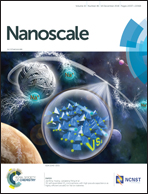A needle-like optofluidic probe enables targeted intracellular delivery by confining light-nanoparticle interaction on single cell†
Abstract
Intracellular delivery of molecular cargo is the basis for a plethora of therapeutic applications, including gene therapy and cancer treatment. A very efficient method to perform intracellular delivery is the photo-activation of nanomaterials that have been previously directed to the cell vicinity and bear releasable molecular cargo. However, potential in vivo applications of this method are limited by our ability to deliver nanomaterials and light in tissue. Here, we demonstrate intracelullar delivery using a needle-like optofluidic probe capable of penetrating soft tissue. Firstly, we used the optofluidic probe to confine an intracellular delivery mixture, composed of 100 nm gold nanoparticles (AuNP) and membrane-impermeable calcein, in the vicinity of cancer cells. Secondly, we delivered nanosecond (ns) laser pulses (wavelength: 532 nm; duration: 5 ns) using the same probe and without introducing a AuNP cells incubation step. The AuNP photo-activation caused localized and reversible disruption of the cell membrane, enabling calcein delivery into the cytoplasm. We measured 67% intracellular delivery efficacy and showed that the optofluidic probe can be used to treat cells with single-cell precision. Finally, we demonstrated targeted delivery in tissue (mouse retinal explant) ex vivo. We expect that this method can enable nanomaterial-assisted intracellular delivery applications in soft tissue (e.g. brain, retina) of small animals.



 Please wait while we load your content...
Please wait while we load your content...